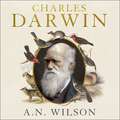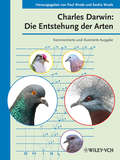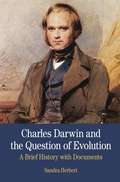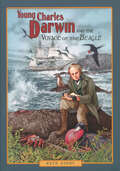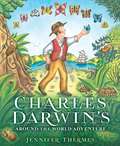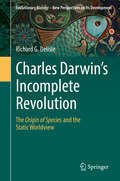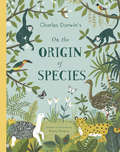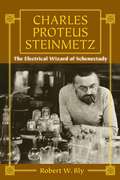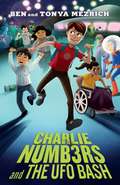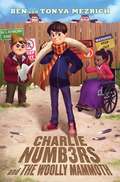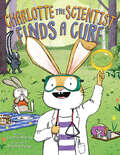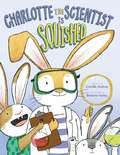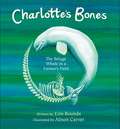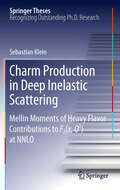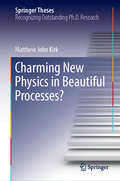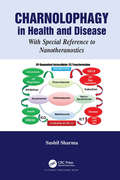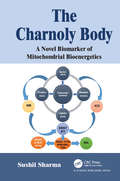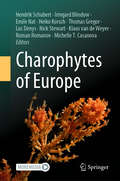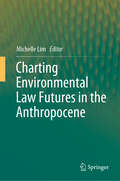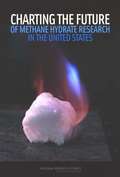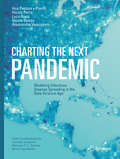- Table View
- List View
Charles Darwin: Victorian Mythmaker
by A N WilsonCharles Darwin: the man who discovered evolution? The man who killed off God? Or a flawed man of his age, part genius, part ruthless careerist who would not acknowledge his debts to other thinkers?In this bold new life - the first single volume biography in twenty-five years - A. N. Wilson, the acclaimed author of The Victorians and God's Funeral, goes in search of the celebrated but contradictory figure Charles Darwin.Darwin was described by his friend and champion, Thomas Huxley, as a 'symbol'. But what did he symbolize? In Wilson's portrait, both sympathetic and critical, Darwin was two men. On the one hand, he was a naturalist of genius, a patient and precise collector and curator who greatly expanded the possibilities of taxonomy and geology. On the other hand, Darwin, a seemingly diffident man who appeared gentle and even lazy, hid a burning ambition to be a universal genius. He longed to have a theory which explained everything.But was Darwin's 1859 master work, On the Origin of Species, really what it seemed, a work about natural history? Or was it in fact a consolation myth for the Victorian middle classes, reassuring them that the selfishness and indifference to the poor were part of Nature's grand plan? Charles Darwin: Victorian Mythmaker is a radical reappraisal of one of the great Victorians, a book which isn't afraid to challenge the Darwinian orthodoxy while bringing us closer to the man, his revolutionary idea and the wider Victorian age.(P)2017 John Murray Press Limited
Charles Darwin: Victorian Mythmaker
by A.N. WilsonA radical reappraisal of Charles Darwin from the bestselling author of Victoria: A Life.With the publication of On the Origin of Species, Charles Darwin—hailed as the man who "discovered evolution"—was propelled into the pantheon of great scientific thinkers, alongside Galileo, Copernicus, and Newton. Eminent writer A. N. Wilson challenges this long-held assumption. Contextualizing Darwin and his ideas, he offers a groundbreaking critical look at this revered figure in modern science.In this beautifully written, deeply erudite portrait, Wilson argues that Darwin was not an original scientific thinker, but a ruthless and determined self-promoter who did not credit the many great sages whose ideas he advanced in his book. Furthermore, Wilson contends that religion and Darwinism have much more in common than it would seem, for the acceptance of Darwin's theory involves a pretty significant leap of faith.Armed with an extraordinary breadth of knowledge, Wilson explores how Darwin and his theory were very much a product of their place and time. The "Survival of the Fittest" was really the Survival of Middle Class families like the Darwins—members of a relatively new economic strata who benefited from the rising Industrial Revolution at the expense of the working classes. Following Darwin’s theory, the wretched state of the poor was an outcome of nature, not the greed and neglect of the moneyed classes. In a paradigm-shifting conclusion, Wilson suggests that it remains to be seen, as this class dies out, whether the Darwinian idea will survive, or whether it, like other Victorian fads, will become a footnote in our intellectual history.Brilliant, daring, and ambitious, Charles Darwin explores this legendary man as never before, and challenges us to reconsider our understanding of both Darwin and modern science itself.
Charles Darwin: Die Entstehung der Arten
by Paul Wrede Saskia WredeDas grundlegende Werk von Darwin On the Origin of Species liegt hier in der originalen Übersetzung durch Julius Victor Carus vor, erweitert durch zahlreiche Erläuterungen, aussagekräftige Abbildungen sowie wichtige historische Bezüge. Die Entstehung der Arten von Darwin ist für die heutige Leserschaft häufig schwierig zu verstehen. Eine hilfreiche Unterstützung erfolgt durch die farbliche Hervorhebung entscheidender Textstellen und viele fachliche Erklärungen. Darwins Analysen und Bewertungen aus den Gebieten der Botanik, Zoologie, Verhaltenslehre, Paläontologie und Entwicklungsbiologie werden in acht Beiträgen namhafter Fachwissenschaftler im Licht der gegenwärtigen Forschung beleuchtet und so wird erst die ungeheure Bedeutung und Weitsicht seines Werkes offensichtlich. Endlich liegen jetzt die Übersetzungen der beiden ebenso bahnbrechenden Aufsätze von Alfred Russel Wallace vor: der Sarawak- und Ternate-Essay. Wallace war neben Darwin der bedeutendste Evolutionsforscher seiner Zeit. Seine Arbeiten zur Evolutionsbiologie, die im Angelsächsischen hoch geschätzt sind, können als durchaus gleichrangig zu Darwins berühmtester Schrift angesehen werden. Ulrich Kutschera eröffnet das Buch mit einem Geleitwort und Reinhold Leinfelder schließt es mit einem Ausblick zur Bedeutung der Evolutionstheorie für die Zukunft des Menschen ab. Das Buch ist daher nicht nur eine unverzichtbare Lernhilfe für Schüler und Studenten, die sich mit der Evolutionsbiologie beschäftigen, sondern zusätzlich auch eine spannende weiterführende Lektüre für alle Leser mit Interesse an Wissenschaftsgeschichte.
Charles Darwin and the Question of Evolution: A Brief History With Documents
by Sandra HerbertThe publication of Charles Darwin's On the Origin of Species in 1859 is widely regarded as a turning point in knowledge of the natural world. But Darwin's theory of natural selection was not developed in a vacuum; rather, it represents the culmination of an enormous shift in scientific and popular opinion on the subject of species mutability from the late eighteenth century onward. Through her insightful introduction and engaging collection of documents, Sandra Herbert examines this era of scientific thought and the startling discoveries that led Darwin and others to the conclusion that life has evolved. A wide range of documents from over a dozen authors -- including letters, illustrations, scientific tracts, and excerpts from Darwin's own notebooks and On the Origin of Species -- offer a fascinating glimpse into this crucial era of scientific thought. Thoughtful document headnotes, questions for consideration, a chronology, and a selected bibliography provide students with additional context and pedagogical support.
Charles Darwin and the Voyage of the Beagle
by Ruth AshbyIn 1831, young adventurer and nature enthusiast Charles Darwin set sail on a remarkable five-year voyage that changed the study of biology forever.Award-winning author Ruth Ashby shares the story of Darwin's famous journey aboard the British navy ship, the Beagle, which led to the development of his theories of evolution and natural selection.This lively account follows the naturalist's exciting trip around the world—through seasickness, a life-threatening illness, and even an earthquake—as he explores South America, the Cape Verde Islands, Tahiti, and the Galapagos Islands. During his travels, Darwin meets Indigenous peoples and carefully collects and catalogs plants, fossils, birds, mammals, and insects. Darwin's observations of the distribution and diversity of plant and animal life ultimately leads to the development of his theories on evolution.Readers will be inspired by Darwin's transformation from talented but mediocre schoolboy into a remarkable scientist as they read about the revolutionary voyage that forever changed the world of biology.
Charles Darwin - Leben und Werk: Würdigung eines großen Naturforschers und kritische Betrachtung seiner Lehre
by Wolfgang SchaumannVor 200 Jahren wurde einer der größten und bis heute umstrittenen Naturforscher geboren: Charles Darwin. Der Autor Wolfgang Schaumann schildert in seiner kritischen Würdigung von Darwins Lebenswerk historische und höchst aktuelle Auseinandersetzungen mit Darwins revolutionärer Theorie zur Evolution der Arten, die erstmals im Jahre 1859 von ihm veröffentlicht wurde. In einem Spannungsbogen, der sich über 150 Jahre hinzieht, lässt Schaumann den Leser miterleben, wie Darwins revolutionäre Theorie allen gegen sie vorgebrachten Argumenten getrotzt hat und sich gegen sämtliche Alternativtheorien immer wieder durchsetzen konnte. Spannend und lehrreich zugleich!
Charles Darwin's Around The World Adventure
by Jennifer ThermesIn 1831, Charles Darwin embarked on his first voyage. Though he was a scientist by profession, he was an explorer at heart. While journeying around South America for the first time aboard a ninety-foot-long ship named the Beagle, Charles collected insets, dug up bones, galloped with gauchos, encountered volcanoes and earthquakes, and even ate armadillo for breakfast! The discoveries he made during this adventure would later inspire ideas that changed how we see the world. <p><p> Complete with mesmerizing map work that charts Darwin's thrilling five-year voyage, as well as "Fun Facts" and more, Charles Darwin's Around-the-World Adventure captures the beauty and mystery of nature with wide-eyed wonder.
Charles Darwin’s Barnacle and David Bowie’s Spider: How Scientific Names Celebrate Adventurers, Heroes, and Even a Few Scoundrels
by Stephen B. HeardAn engaging history of the surprising, poignant, and occasionally scandalous stories behind scientific names and their cultural significance Ever since Carl Linnaeus&’s binomial system of scientific names was adopted in the eighteenth century, scientists have been eponymously naming organisms in ways that both honor and vilify their namesakes. This charming, informative, and accessible history examines the fascinating stories behind taxonomic nomenclature, from Linnaeus himself naming a small and unpleasant weed after a rival botanist to the recent influx of scientific names based on pop-culture icons—including David Bowie&’s spider, Frank Zappa&’s jellyfish, and Beyoncé&’s fly. Exploring the naming process as an opportunity for scientists to express themselves in creative ways, Stephen B. Heard&’s fresh approach shows how scientific names function as a window into both the passions and foibles of the scientific community and as a more general indicator of the ways in which humans relate to, and impose order on, the natural world.
Charles Darwin's Incomplete Revolution: The Origin of Species and the Static Worldview (Evolutionary Biology – New Perspectives on Its Development #1)
by Richard G. DelisleThis book offers a thorough reanalysis of Charles Darwin's Origin of Species, which for many people represents the work that alone gave rise to evolutionism. Of course, scholars today know better than that. Yet, few resist the temptation of turning to the Origin in order to support it or reject it in light of their own work. Apparently, Darwin fills the mythical role of a founding figure that must either be invoked or repudiated. The book is an invitation to move beyond what is currently expected of Darwin's magnum opus. Once the rhetorical varnish of Darwin's discourses is removed, one discovers a work of remarkably indecisive conclusions. The book comprises two main theses: (1) The Origin of Species never remotely achieved the theoretical unity to which it is often credited. Rather, Darwin was overwhelmed by a host of phenomena that could not fit into his narrow conceptual framework. (2) In the Origin of Species, Darwin failed at completing the full conversion to evolutionism. Carrying many ill-designed intellectual tools of the 17th and 18th centuries, Darwin merely promoted a special brand of evolutionism, one that prevented him from taking the decisive steps toward an open and modern evolutionism. It makes an interesting read for biologists, historians and philosophers alike.
Charles Darwin's On the Origin of Species
by Sabina RadevaA picture book adaptation of Charles Darwin's groundbreaking On the Origin of Species, lushly illustrated and told in accessible and engaging easy-to-understand text for young readers.On the Origin of Species revolutionized our understanding of the natural world. Now young readers can discover Charles Darwin's groundbreaking theory of evolution for themselves in this stunning picture-book adaptation that uses stylish illustrations and simple text to introduce how species form, develop, and change over time.
Charles Fort: Prophet of the Unexplained
by Damon KnightFrom the book: Charles Fort was convinced that there is a great deal going on in our universe which man has not as yet been able to explain. He was, of course, right. Fort amassed reports of events allegedly observed by humans around the world. Fort's books are full of reports of strange phenomena-such as those similar in every way to today's reports of flying saucers but centuries before they were called flying saucers. Boole gave scientists a powerful tool for attacking problems when the obvious approaches refused to yield informative results. Boole employed reductio ad absurdum. He exhausted all the impossibles and thereby isolated a "very probable" answer. Charles Fort, failing to gain the publishers'-and thereby society's-consideration of his positive theories, left world society with a Boolean-like confrontation of illogical events. Charles Fort as a man of true vision purposefully inverted the equations. By getting the publishers to publish the absurd, he proved his point that the publishers published only the absurd.
Charles Proteus Steinmetz
by Robert W. BlyRevered in the late 19th and early 20th centuries as a genius, but largely forgotten today, Steinmetz made the modern world possible through his revolutionary work on AC electricity transmission, the technology underlying today's power grid. More than just a great scientist and engineer, Steinmetz was also one of the most colorful characters in American life. Standing just four feet tall with a pronounced spine curvature, Steinmetz was as well known for his fiery political opinions, his fierce advocacy for social progress and education, his unusual home life, and his private menagerie as for his technical achievements.
Charlie Numbers and the UFO Bash (The Charlie Numbers Adventures)
by Ben Mezrich Tonya MezrichCharlie and the Whiz Kids must separate fact from otherworldly fiction as they set out to find their missing classmate in this action-packed fourth novel of the Charlie Numbers Adventures series.As his school&’s resident numbers guy, Charlie Lewis has always thought that if something can&’t be proven with a math equation, it might as well be myth—which is exactly how he feels about UFOs. Charlie just can&’t believe in the existence of aliens without verifiable proof. Not even Janice, who&’s the smartest kid Charlie knows, can convince him. But when Charlie&’s classmate Anthem mysteriously disappears after bringing a supposed space rock to show-and-tell, it&’s up the Whiz Kids to uncover the truth. As Charlie and the gang trace Anthem&’s steps to his eerily empty house, it soon becomes clear that perhaps Anthem and his father are involved in something much bigger than a lost rock. From meeting with UFO enthusiasts, sneaking into hidden rooms, and being following by shadowy and dangerous agents, Charlie is finding it more and more difficult to stick to his convictions—because what if aliens do exist?
Charlie Numbers and the Woolly Mammoth (The Charlie Numbers Adventures)
by Ben Mezrich Tonya MezrichCharlie and the Whiz Kids discover a prehistoric mammoth tusk and stumble right into the nefarious clutches of an eccentric billionaire in this hilarious third novel of the Charlie Numbers series.Charlie Numbers and his gang of Whiz Kids—along with a few new allies—are on another mission: this time, to uncover the truth behind the mysterious mammoth tusk they found buried in the Boston Public Gardens. Their hunch? Blake Headstrom, eccentric billionaire, philanthropist, and collector of some renown, has been smuggling mammoth tusks into the city. The only question is: Why? Selling woolly mammoth tusks isn&’t illegal…but selling elephant ivory is. And Charlie&’s certain Headstrom&’s plans are more sinister than they seem. But Headstrom is a powerful man, with powerful connections. If the Whiz Kids want to expose him for the criminal they know he is, they&’re going to have to catch him red-handed. Now if only Headstrom&’s henchmen weren&’t lurking at every turn…
Charlotte the Scientist Finds a Cure (Charlotte the Scientist)
by Camille AndrosIn this empowering picture book with a STEM focus, Charlotte, a budding bunny scientist, ignores the doubters and confidently finds a cure to the mysterious malady affecting the forest. The animals of the forest are all getting sick and no one can figure out why. Determined to get to the bottom of the mystery and help her friends and family, Charlotte dives into some serious medical science. But when the doctors and other scientists don&’t take her work seriously, she sets out to find a cure on her own, determined to show that she can make a difference. This empowering story about a smart, confident bunny encourages girls to be persistent and believe in themselves.
Charlotte the Scientist Is Squished (Charlotte the Scientist)
by Camille Andros Brianne FarleyCharlotte is a serious scientist. She solves important problems by following the scientific method. She has all the right equipment: protective glasses, a lab coat, a clipboard, and a magnifying glass. What she doesn’t have is space. She has so many brothers and sisters (she is a rabbit, after all) that she is too squished to work on her experiments! Can she use science to solve her problem? This funny, satisfying story is a playful introduction to the scientific method and perfect for sparking an interest in STEM subjects.
Charlotte's Bones: The Beluga Whale In A Farmer's Field (Tilbury House Nature Book #0)
by Erin Rounds Alison CarverMany thousands of years ago, when a sheet of ice up to a mile thick began to let go of the land, the Atlantic Ocean flooded great valleys that had been scooped out by glaciers, and the salty waves of an inland sea lapped the green hills of Vermont. Into this arm of the sea swam Charlotte. Her milky, smooth, muscled body sliced slowly through the water like scissors through silk. Like a chirping canary, her voice echoed across dark waters showing the way to her pod as belugas have done for millions of years. In 1849, a crew building a railroad through Charlotte, Vermont, dug up strange and beautiful bones in a farmer’s field. A local naturalist asked Louis Agassiz to help identify them, and the famous scientist concluded that the bones belonged to a beluga whale. But how could a whale’s skeleton have been buried so far from the ocean? The answer—that Lake Champlain had once been an arm of the sea—encouraged radical new thinking about geological time scales and animal evolution. Charlotte’s Bones is a haunting, science-based reconstruction of how Charlotte died 11,000 years ago in a tidal marsh, how the marsh became a field, how Charlotte found a second life as the Vermont state fossil, and what messages her bones whisper to us now about the fragility of life and our changing Earth. Lexile 940; F&P Level P
Charm Production in Deep Inelastic Scattering: Mellin Moments of Heavy Flavor Contributions to F2(x,Q^2) at NNLO (Springer Theses)
by Sebastian KleinThe production of heavy quarks in high-energy experiments offers a rich field to study, both experimentally and theoretically. Due to the additional quark mass, the description of these processes in the framework of perturbative QCD is much more demanding than it is for those involving only massless partons. In the last two decades, a large amount of precision data has been collected by the deep inelastic HERA experiment. In order to make full use of these data, a more precise theoretical description of charm quark production in deep inelastic scattering is needed. This work deals with the first calculation of fixed moments of the NNLO heavy flavor corrections to the proton structure function F2 in the limit of a small charm-quark mass. The correct treatment of these terms will allow not only a more precise analysis of the HERA data, but starting from there also a more precise determination of the parton distribution functions and the strong coupling constant, which is an essential input for LHC physics. The complexity of this calculation requires the application and development of technical and mathematical methods, which are also explained here in detail.
Charming New Physics in Beautiful Processes? (Springer Theses)
by Matthew John KirkThis PhD thesis is dedicated to a subfield of elementary particle physics called “Flavour Physics”. The Standard Model of Particle Physics (SM) has been confirmed by thousands of experimental measurements with a high precision. But the SM leaves important questions open, like what is the nature of dark matter or what is the origin of the matter-antimatter asymmetry in the Universe. By comparing high precision Standard Model calculations with extremely precise measurements, one can find the first glimpses of the physics beyond the SM – currently we see the first hints of a potential breakdown of the SM in flavour observables. This can then be compared with purely theoretical considerations about new physics models, known as model building. Both precision calculations and model building are extremely specialised fields and this outstanding thesis contributes significantly to both topics within the field of Flavour Physics and sheds new light on the observed anomalies.
Charnolophagy in Health and Disease: With Special Reference to Nanotheranostics
by Sushil SharmaThis book introduces charnolophagy (CP) as energy-driven, lysosomal-dependent mitochondrial inclusion-specific pleomorphic Charnoly body (CB) autophagy (ATG) involving free radical-induced Ca2+ dyshomeostasis, ΔΨ collapse, and ATP depletion in congenital diseases, pressure ulcers, metabolic diseases, hepatic diseases, diabetes, obesity, inflammatory diseases, musculoskeletal diseases, sarcopenia, cachexia, respiratory diseases, gastrointestinal diseases, hyperlipidemia, skin and hair diseases, pulmonary diseases, cardiovascular diseases, renal diseases, sepsis-induced multi-organ failure, reproductive diseases, inflammatory diseases, ophthalmic diseases, neurodegenerative diseases, drug addiction, aging, microbial (including COVID-19) infections, and belligerent malignancies implicated in early morbidity and mortality and disease-specific spatiotemporal, targeted, safe, and effective evidence-based personalized theranostic charnolopharmacotherapeutics to cure them. Basic DRESS and GELS principles, nanoparticles to cure chronic multidrug-resistant (MDR) diseases, antioxidants as free radical scavengers, CB antagonists, CP regulators, and CS stabilizers to curb CB molecular pathogenesis (CBMP) are described for better quality of life and longevity. Specific guidelines for environmental protection and preservation of zoological and botanical species at the verge of extinction, Triple "I" Hypothesis for mitochondrial quality control, and transcriptional regulation of CSexR and CSendoR to cure chronic diseases are presented. Novel CP index is introduced to evaluate MDR malignancies and other chronic diseases. WHO, CDC, FDA, NIH, policy planners, cosmetologists, trichologists, players, athletes, dancers, wrestlers, equestrians, young women, aging population, toxicologists, environmental protectionists, pharmaceutical industry, biomedical scientists, researchers, medical students, physicians, nurses, paramedical professionals, and global audience will be interested in this interesting book to prevent pandemics and raise healthcare awareness.
The Charnoly Body: A Novel Biomarker of Mitochondrial Bioenergetics
by Sushil SharmaDiversified physicochemical injuries trigger Charnoly body (CB) formation as pleomorphic, electron-dense, multi-lamellar stacks of nonfunctional mitochondrial membranes in the most vulnerable cell. Free radicals induce downregulation of mitochondrial DNA, microRNA, AgNOR, and epigenetics to trigger CB molecular pathogenesis. CB is eliminated by energy (ATP)-driven lysosome-dependent charnolophagy as a basic molecular mechanism of intracellular detoxification to prevent acute and chronic diseases. Accumulation of CB at the junction of axon hillock and charnolosome (CS) at the synapses causes cognitive impairments; whereas, nonspecific induction of CB causes GIT stress, myelosuppression, alopecia, neurotoxicity, cardiotoxicity, and infertility in multidrug-resistant malignancies. Hence, stem cell-specific CB, charnolophagy, and CS agonists/antagonists are introduced as novel charnolopharmacotherapeutics for the successful treatment of cardiovascular diseases, neurodegenerative diseases, infectious diseases, drug addiction, and cancer. Nanoparticles to improve drug delivery, CS exocytosis, and disease-specific spatiotemporal charnolosomics employing correlative and combinatorial bioinformatics boost mitochondrial bioenergetics through balanced diet, exercise, and antioxidants. The book will be of interest to medical scientists and practitioners.
Charophytes of Europe
by Hendrik Schubert Irmgard Blindow Emile Nat Heiko Korsch Thomas Gregor Luc Denys Nick Stewart Klaus van de Weyer Roman Romanov Michelle T. CasanovaThis book covers whole Europe within its geographical limits, providing not only an overview about biogeography and recent taxonomic status of Charophyte species but also in-depth information about recent knowledge about ecology, ontogenesis, morphology, palaeontology and systematics of this group of algae. This is the first comprehensive treatment of European Charophytes. In addition, the reader for the first time is provided by definitions of terms applied to Charophytes, sorting out several previous confusions about terminology. Special attention was paid on oospores in order to exploit their potential for supporting species delineation as well as analysis of sediment records. A red list, dealing also with threats and habitat conditions, completes the book.Altogether more than 70 taxon are described in detail, each of the descriptions giving full information about morphology, habitat conditions, distribution as well as variability; important characters for determination are illustrated by photographs and drawings. Hints for correct determination are given in a separate para, allowing correct species delineation even for critical species. This, together with a set of determination keys, will allow beginners and practitioners to get familiar with the determination of Charophytes, being often regarded notoriously difficult in the past.Authored by a large group of 70 specialists from all over Europe and Overseas, a commonly agreed taxonomy is provided, and all debates about taxonomic status and nomenclatural problems have been discussed beforehand extensively. By this, a sound reference for applied aspects is given, allowing for reliable cross-country comparisons especially with respect to bioindication purposes but also serving ground for biogeographical research, biodiversity issues and the emerging field of elucidating the process of territorialisation of land plants. The authors hope that this book will become the reference work for the coming decades it was designed for.
Charting Environmental Law Futures in the Anthropocene
by Michelle LimThis book explores a range of plausible futures for environmental law in the new era of the Earth’s history: the Anthropocene. The book discusses multiple contemporary and future challenges facing the planet and humanity. It examines the relationship between environmental law and the Anthropocene at governance scales from the global to the local. The breadth of issues and jurisdictions covered by the book, its forward-looking nature, and the unique generational perspective of the contributing authors means that this publication appeals to a wide audience from specialist academics and policy-makers to a broader lay readership.
Charting The Future Of Methane Hydrate Research In The United States
by Committee to Review the Activities Authorized Under the Methane Hydrate Research Development Act of 2000Methane hydrate is a natural form of clathrate - a chemical substance in which one molecule forms a lattice around a "guest" molecule with chemical bonding. In this clathrate, the guest molecule is methane and the lattice is formed by water to form an ice-like solid. Methane hydrate has become the focus of international attention because of the vast potential for human use worldwide. If methane can be produced from hydrate, a reasonable assumption given that there are no obvious technical or engineering roadblocks to commercial production, the nation's natural gas energy supply could be extended for many years to come. This report reviews the Department of Energy's (DOE) Methane Hydrate Research and Development Program, the project selection process, and projects funded to date. It makes recommendations on how the DOE program could be improved. Key recommendations include focusing DOE program emphasis and research in 7 priority areas; incorporating greater scientific oversight in the selection, initiation, monitoring, and assessment of major projects funded by the DOE; strengthening DOE's contribution to education and training through funding of fellowships, and providing project applicants with a set of instructions and guidelines outlining requirements for timely and full disclosure of project results and consequences of noncompliance.
Charting the Next Pandemic: Modeling Infectious Disease Spreading in the Data Science Age
by Alessandro Vespignani Luca Rossi Bruno Gonçalves Nicola Perra Ana Pastore y Piontti Nicole Samay Corrado Gioannini Marcelo F. GomesThis book provides an introduction to the computational and complex systems modeling of the global spreading of infectious diseases. The latest developments in the area of contagion processes modeling are discussed, and readers are exposed to real world examples of data-model integration impacting the decision-making process. Recent advances in computational science and the increasing availability of real-world data are making it possible to develop realistic scenarios and real-time forecasts of the global spreading of emerging health threats.The first part of the book guides the reader through sophisticated complex systems modeling techniques with a non-technical and visual approach, explaining and illustrating the construction of the modern framework used to project the spread of pandemics and epidemics. Models can be used to transform data to knowledge that is intuitively communicated by powerful infographics and for this reason, the second part of the book focuses on a set of charts that illustrate possible scenarios of future pandemics. The visual atlas contained allows the reader to identify commonalities and patterns in emerging health threats, as well as explore the wide range of models and data that can be used by policy makers to anticipate trends, evaluate risks and eventually manage future events.Charting the Next Pandemic puts the reader in the position to explore different pandemic scenarios and to understand the potential impact of available containment and prevention strategies. This book emphasizes the importance of a global perspective in the assessment of emerging health threats and captures the possible evolution of the next pandemic, while at the same time providing the intelligence needed to fight it. The text will appeal to a wide range of audiences with diverse technical backgrounds.
